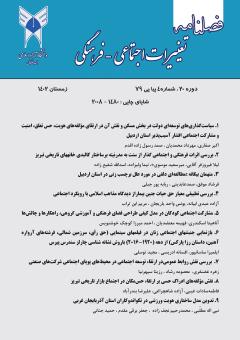مشارکت اجتماعی کودکان در مدل کیفی طراحی فضای فرهنگی و آموزشی گروهی، راهکارها و چالشها
محورهای موضوعی : جنبشهای اجتماعیآناهیتا اسکندری 1 , فهیمه معتضدیان 2 , احمد میرزا کوچک خوشنویس 3
1 - دانشجوی دورۀ دکتری تخصصی معماری، واحد پردیس، دانشگاه آزاداسلامی، پردیس، ایران.
2 - استادیار گروه معماری، واحد پردیس، دانشگاه آزاداسلامی، پردیس، ایران.
3 - استادیار گروه گردشگری، پژوهشگاه میراثفرهنگی و گردشگری، تهران، ایران.
کلید واژه: فضایآموزشی, خلاقیت, طراحی, مشارکت, کودکان پیشدبستانی.,
چکیده مقاله :
آموزش و محیطهای آموزشی از جنبههای فرهنگی و اجتماعی، بیشترین اثر را بر ذهنیت و تمدنسازی جوامع برعهده دارند؛ بهرهمندی از فضای آموزشی مناسب درجهت پرورش استعدادها و مهارتهای اجتماعی، فرهنگی کودکان ضروری است. لازمۀ آن، ایجاد فضاهای مرتبطبا فعالیت دانشآموزان، که دارای شرایط مطلوب برای رشد فیزیکی، ذهنی، عاطفی و اجتماعی کودکان باشد، است و تحقق آن ازطریق طراحی جزئیات فضاها باتوجهبه الگوهای فرهنگی_رفتاری کودکان امکانپذیر میگردد. هدف، ارائۀ مدل طراحی فضای آموزشی گروهی با مشارکت کودکان پیشدبستانی در فرایند طراحی میباشد. روشتحقیق، ترکیب روش کمی-کیفی است و نتایج، به گروههای شناختی و فیزیکی تقسیم شده است. نتایج فیزیکی شامل: رنگ و شکل احجام، متریال و چیدمان است و نتایج شناختی: از زوایای فرهنگی، افزایش آگاهی از تاریخ، هنر و نحوۀ شکلگیری فضاها و تقویت زیرساختهای فرهنگی کودکان و افزایش ارتباط آنان با محیطهای پیرامونی و ازنظر اجتماعی، توسعۀ مهارتهای ارتباطی و تعاملی، ایجاد همافزایی، همکاری و تحلیل محیطی در تعاملات اجتماعی و ارتباطاتی بوده است. آموزش معماری در تقویت هویت فردی و فرهنگی کودکان نقش مؤثری دارد و این یافتهها میتواند در طراحی فضاهای آموزشی کودکان با جهتدهی مشارکت کودکان و تأمین نیازهای آنان مؤثر باشد.
Education and educational environments wield immense influence over societal mentality and civilization, notably through cultural and social lenses. Fostering a dynamic, creative education nurtures children's intellectual, social, cultural, and creative growth. Crucially, reforming educational structures necessitates the meticulous design of spaces intricately linked to students' activities, finely attuned to optimize the holistic growth—physical, mental, emotional, and social—of children. This research endeavors to introduce a comprehensive model for the design of group educational spaces, emphasizing the active participation of preschool children throughout the design process. Employing a nuanced amalgamation of quantitative and qualitative methodologies, the study underscored the pivotal role of architectural education, revealing starkly divergent outcomes between control and test groups. Physical elements, such as the interplay of color schemes, spatial configurations, and the predilection for well-illuminated, open spaces adorned with natural light and transparent architectural elements, emerged prominently. Additionally, the study unveiled the paramount importance of fostering spaces conducive to peer dialogue, artistic expression, comfort-enhancing large cushions, personalized areas, circular tables, and verdant, green surroundings. These insights pave the way for shaping educational spaces to meet children's needs, fostering an enriched and inclusive learning environment through their active involvement.


